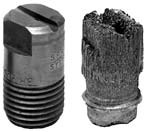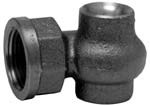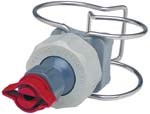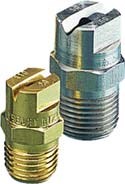The Value of Spray System Optimization
Pretreatment systems are too often perceived as being pretty simple. A few pipes, a pump, some liquid and a few spray nozzles. What could be simpler? As long as the pump is working and the nozzles are spraying everything's fine, right? In many cases, the reality of what your system is actually producing couldn't be farther from that statement. When it comes to your system's spraying performance, if you don't have a comprehensive Spray System Optimization Plan in place, it may be costing your company thousands of dollars per year...
Spray nozzles are a precision component of your pretreatment system, designed to produce a specific performance under very specific conditions. Just because a nozzle is spraying doesn't mean that its working properly. As you'll see, many factors can reduce the efficiency of a spray nozzle and ultimately your entire system.
To achieve long-term, optimal performance, you need to examine your entire spray system and develop a plan to evaluate, monitor and maintain it on a regular basis. If you don't have a Spray System Optimization Plan in place already, now is a good time to establish one.
Why is Spray System Optimization So Important?
When your system isn't performing to peak efficiency, you will start to experience a variety of very costly problems. You may be seeing definite signs, now, that can alert you to an immediate need for system maintenance:
- Increased consumption of costly chemicals, water and electricity
- Quality issues of your end product
- Increased maintenance
- Unscheduled downtime
- Negative environmental impact
The resulting costs of any of these can be surprising, if not staggering. The annual cost of wasted water alone, in a system operating with as little as 15% waste, can amount to more than 28 million gallons of loss, with an estimated dollar amount of $90,000.00. Wasted chemical costs can be in excess of $3,000,000 per year.†
How much can an optimized system save you? It may be difficult to calculate your savings on your own, so a good tool to have is a spray system savings calculator. One can be found at www.spray.com/save. The calculator asks a few simple questions about your system, typical maintenance, water costs, etc. and estimates your potential annual savings.
Once you understand the financial impact that spray system optimization can have in your plant, you'll want to take steps to establish your own Optimization Program. So, where do you start? First, start by assessing your system. Not as it is performing now, but as it was intended to operate when it was installed. Evaluate your nozzle selections. Establish a benchmark for proper flow, spraying pressures, nozzle spray patterns and angles and total system capacities. From there you can begin to evaluate these same items in your system's current state. While making your evaluation, remember to document any specific problems you may be having with regard to product quality, increases in chemical or water use, etc.
Choosing the Right Nozzle Makes All the Difference
Spray system optimization begins with the right nozzle, or set of nozzles. Spray nozzles are available in four basic spray patterns. The first step is deciding which of these is best for your application.
In multi-stage washers or phosphating operations, quick-connect or clip-on nozzle styles are the most commonly used. These nozzles use a single or double metal spring clip, allowing it to be snapped onto a predrilled header for fast installation. Each adjustable, plastic nozzle body is resistant to most corrosive materials and can reduce nozzle caking. They offer various nozzles for washing, rinsing, phosphating and seal (final) rinsing. The more popular nozzles offer quick-change removable spray tips, allowing you to change-out worn or clogged tips with a simple twist of the wrist, which can save several hours in normal system maintenance.
Quick-change nozzles are also available with threaded connections. The all-plastic design makes them an ideal choice for use in corrosive environments, phosphate spraying, acids or caustic solutions. Their quick-change design allows for easy tip removal and replacement. The "winged" design of these tips provides an easy grip for changing in wet conditions and serves as an alignment feature for the spray pattern.
Spray nozzles are available in many spray patterns, spray angles and capacities. Nozzle materials vary with the specific application, but the more common are brass, stainless steel (in varying grades), plastics such as polypropylene, PVC, CPVC, PVDF, etc. and specialty metals. If you're unsure which is the best nozzle and material for your specific application, contact your equipment manufacturer or a spray nozzle supplier in your area.
The Symptoms of Nozzle Problems
Once the proper nozzles have been selected and installed, it's important to monitor their performance and make certain they're working as intended. Visual inspection alone cannot tell you if your nozzles are working properly. Some symptoms can't be seen and may require special testing to detect.
Changes in flow rate:
- A nozzle's flow rate will increase as the orifice surface begin to deteriorate
- In applications with positive displacement pumps, which provide the same capacity regardless of pressure, the spraying pressure at the nozzle decreases as the orifice enlarges. Lower spray velocities and spray impact, or impingement, will result.
- Increased flow rates or lowering spray pressures may also result in larger drop sizes.
Deterioration of spray patterns:
- Hollow cone nozzles: As orifice wear occurs, the spray pattern uniformity is destroyed as streaks develop and the pattern becomes heavy varying sections of the spray.
- Full cone nozzles: the spray pattern distribution typically deteriorates as more liquid flows to the center of the pattern.
- Flat fan sprays: Streaks and heavier flows in the center of the spray pattern, along with a decrease in the effective spray angle.
Increased drop size:
- As a nozzle orifice wears, the liquid flow increases or the spraying pressures drop, resulting in higher drop sizes. Larger drops result in less total liquid surface area.
Lower spray impact:
- Spray impact is lowered, as worn nozzles are operating at lower pressures with a positive displacement pump.
- With applications using a centrifugal-type pump, impact may actually increase due to the increased flow though the worn orifice.
Five of the Most Common Reasons Why Spray Nozzles Perform Improperly
Spray system performance can be compromised or rendered totally ineffective by eroding, damaged or obstructed nozzle orifices. Chart 2 shows the five most common problems in the industry.
All of these problems can be eliminated with regular, routine maintenance and proper training. Periodic flow checks, visual inspections, spray pressure monitoring, as well as nozzle alignments are a few items that should be included in every maintenance check list. Many pretreatment system OEM's can offer assistance with a maintenance schedule of their washers. If information is not available, contact a reputable spray nozzle company in your area. They'll be able to provide a complete system audit, inspection and training to get you back on the right
track.
Conclusions
A good Spray System Optimization Plan will have significant benefits to your system, its operating costs and your end product. Taking the initiative now to recognize, correct and prevent nozzle performance problems will probably be the best investment you've made in your washer in a long time. With proper maintenance and nozzle performance, you'll experience reduced operating costs, reduced maintenance costs and downtime, while improving your product
quality.
Replacing your spray nozzles on a regular basis will eliminate wasted water, chemicals, electricity and prevent product rework. Proper nozzle maintenance procedures and scheduled replacement will keep your system running at peak efficiency, ultimately adding to the increased profitability of your operation.
Dave Mielke is a market and technical specialist with Spraying Systems Co., with 28 years of experience in the spray nozzle industry. He's a member of the PCI (Powder Coating Institute), AESF (American Electroplaters & Surface Finishers Society), MFSA (Metal Finishing Suppliers Assoc.) and SME (Society of Manufacturing Engineers).
† Based on a five-day work week, operating 24 hours/day, with a system flow rate of 500 gpm. Estimated water and sewer costs: $0.003 per gallon.
Read Next
Delivering Increased Benefits to Greenhouse Films
Baystar's Borstar technology is helping customers deliver better, more reliable production methods to greenhouse agriculture.
Read MoreMasking Solutions for Medical Applications
According to Custom Fabricating and Supplies, a cleanroom is ideal for converting, die cutting, laminating, slitting, packaging and assembly of medical-grade products.
Read MoreEpisode 45: An Interview with Chandler Mancuso, MacDermid Envio Solutions
Chandler Mancuso, technical director with MacDermid Envio discusses updating your wastewater treatment system and implementing materials recycling solutions to increase efficiencies, control costs and reduce environmental impact.
Read More































